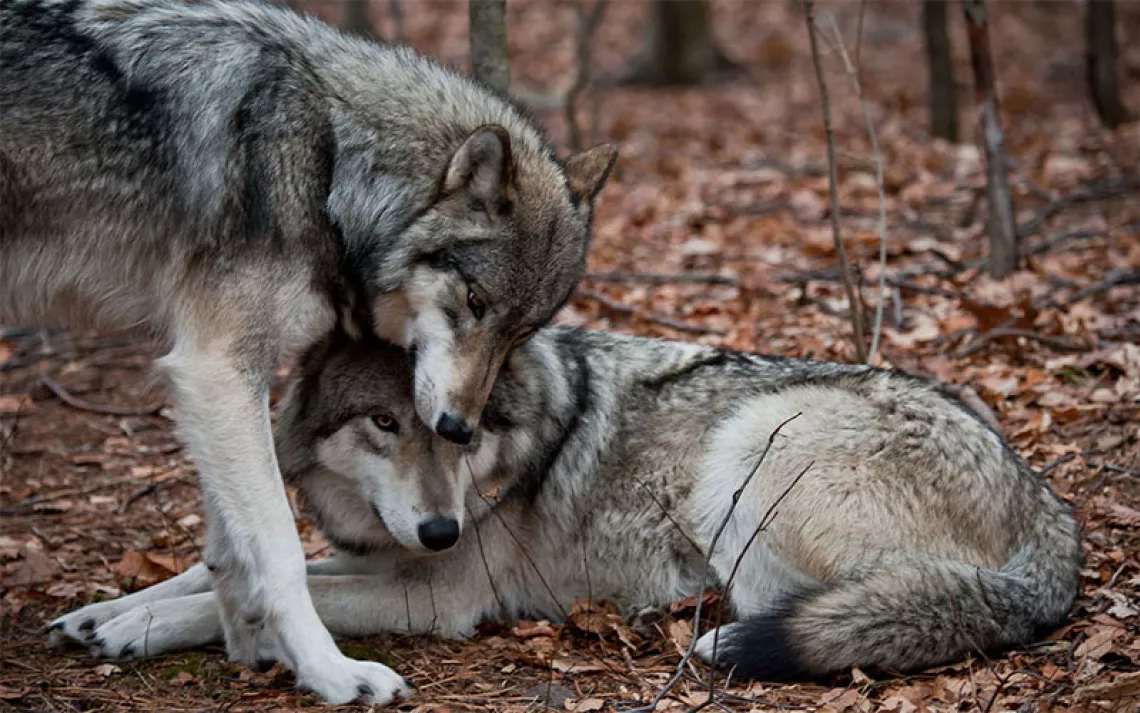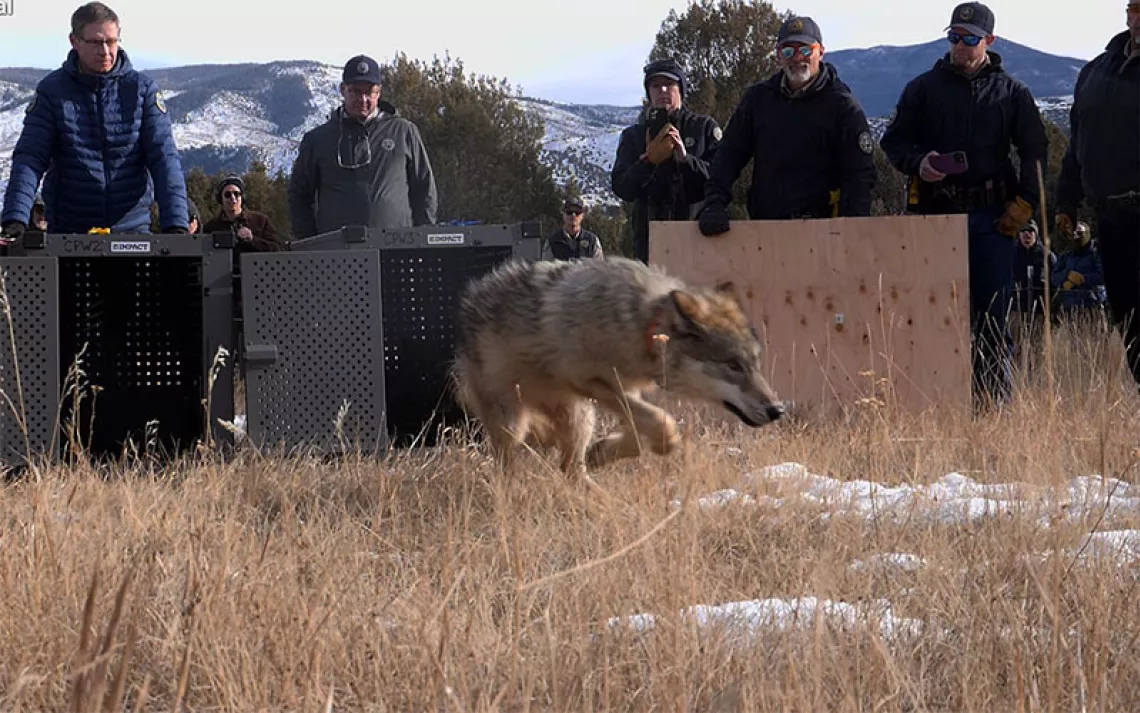A New Dawn for Red Wolves
After years of legal contests, federal officials are poised to reintroduce more red wolves to the wild

Photo by USFWS
Update: On April 21, US Fish and Wildlife announced the discovery of six red wolves born in the wild at Alligator River National Wildlife Refuge. It’s the first wild litter of red wolf pups in four years.
What a difference a new presidential administration can make.
That thought flashed through Perrin de Jong's mind as he scribbled notes during a February public meeting convened by the US Fish and Wildlife Service to discuss developments to save the only wild population of America's red wolf. “The Obama administration abandoned the red wolf recovery program and left them for dead," says de Jong, a staff attorney with the Center for Biological Diversity. After that, the Trump administration proposed to drastically diminish the wolves' protected territory and allow people to kill them if they strayed off federal land. Now, to de Jong’s surprise, the Biden administration’s Fish and Wildlife Service is demonstrating a sharp change in attitude, at least in what they say.
At that February meeting, USFWS officials outlined their plans to release at least nine adult wolves into the wild this spring, including a family group and several breeding pairs. Officials vowed to rebuild the red wolf program to give the critically endangered species a real chance for recovery. They pledged to pursue management techniques that worked in the past, and to consider potential new release locations for the wolves.
If all that happens, it would be a striking turnaround in USFWS’s approach. In 1980, the red wolf was on the brink of extinction. Eventually, captive breeding programs and careful reintroductions in the wild increased the species’ numbers to around 120 animals. But then, advocates say, the agency started to slow-walk red wolf recovery. Today, fewer than 20 red wolves, including just eight collared ones, live in the Alligator River and Pocosin Lakes National Wildlife Refuges in northeastern North Carolina. Another 226 red wolves reside in zoos and other sites through the nation's captive breeding program.
The February meeting's unexpected tone started with leadership at the top. Shannon Estenoz, the US Department of the Interior's new assistant secretary for Fish, Wildlife, and Parks, had met with USFWS field staff in the region and toured the captive breeding operation at the North Carolina Zoo, one of 49 partner institutions across the country preserving genetic diversity in red wolves. Those visits "persuaded me that if we dedicate ourselves to good communication, to transparency, and to collaborative conservation, we will be able to embark on a renewed vision for red wolf recovery," Estenoz promised during the stakeholders' meeting.
By de Jong's reckoning, USFWS pledged to do nearly everything his organization wanted, including resuming "robust" releases of red wolves into the wild population; restarting regular fostering of captive-born pups in wild dens; and sterilizing coyotes in the area to prevent interbreeding. USFWS recommitted to more community engagement with local residents, including a hotline (1-855-4WOLVES) for questions and concerns.
Even so, for de Jong and other red wolf champions, the question remains: Is this really a new era for this endangered species?
Ramona McGee, an attorney with the Southern Environmental Law Center (SELC), is among those not ready to proclaim victory. She points out that the USFWS’s new enthusiasm for red wolf recovery is largely the result of years of litigation waged by her organization and others.
In 2019, the Center for Biological Diversity sued USFWS over its languishing species recovery plan, which at that point hadn't been updated for nearly three decades. Then, in November 2020, the Southern Environmental Law Center sued USFWS on behalf of three conservation groups, alleging the agency violated the Endangered Species Act by failing to implement previously successful management techniques. The plaintiff groups also asked for emergency action to ensure red wolves would be released while litigation continued.
In January 2021, Judge Terrence Boyle ruled that the agency "likely" violated the Endangered Species Act and ordered USFWS to develop a plan for red wolf releases to prevent "irreparable harm" to the species. USFWS said it would release one pair of adult wolves. After SELC filed a legal objection to the plan, USFWS increased that to two pairs. USFWS remains under court order to release more red wolves into the wild.
The government agency's past behavior has made McGee cautious. She emphasizes that to ensure long-term conservation, "we're going to need to see wolves on the ground reproducing and functioning like a true wild population. The current release plan from the Fish and Wildlife Service only goes through May. It's going to take more releases for the population to come close to thriving."
Emily Bizwell Weller, USFWS red wolf recovery lead, won’t predict how many wolves USFWS will reintroduce in total this year and next. "Any further releases would be dependent on suitable conditions being present," she wrote to de Jong in an email shared with Sierra, "and would be communicated to the public and affected landowners in advance. We need the support of all stakeholders to promote the successful outcome of the releases and the continued efforts of red wolf recovery."
Beyond these short-term steps, at the meeting earlier this year officials also outlined what’s next for a new, overarching Red Wolf Recovery Plan. The court agreement in the Center for Biological Diversity lawsuit gives USFWS until February 2023 to revise this guiding document. The team developing revisions includes representatives from all levels of government, Native American tribes, academia, zoos and wildlife conservation centers, nonprofit organizations, and landowners.
Chris Lasher, coordinator of the red wolf captive breeding program, is among them. He hopes the updated recovery plan will identify potential reintroduction locations in the wolf's historic range that may be connected "to allow the wolves to interbreed in different populations."
For now, if all goes well this spring, the released wolves from Zoo Knoxville, Rowan Wild, and other facilities will establish territories and may produce offspring. "Red wolves breed only once a year, and we're right smack dab in the middle of breeding season now," Lasher explains. A wild litter would raise the possibility of more pup fostering. Of the four pups fostered last spring, three adolescents have since been spotted on trail cameras.
For any red wolf to have a chance, officials need to find ways to stop premature deaths. All four adult wolves released last spring have perished. Three were killed in vehicle strikes. The fourth died from a gunshot. It was killed "by a private landowner who indicated the wolf was in the general vicinity of the landowner's chicken coop," according to the USFWS. "The landowner self-reported the incident to North Carolina Wildlife Resource Commission Law Enforcement as soon as it occurred. FWS Special Agents are currently investigating the incident."
It's illegal to shoot a red wolf unless the wolf is menacing the shooter, pets, or livestock. Though in 2018 the Trump administration proposed to drastically diminish the wolves' protected territory and allow people to kill them if they strayed off federal land, the Biden administration withdrew the proposal.
Part of the challenge of keeping red wolves alive is that captive-born wolves must learn to be wild. "Raising wolves in human care is tricky," says Kelly Cox of Zoo Knoxville. "Every attempt is made by their caretakers to maintain their environment in as wild a state as possible, but it cannot be a totally human-free experience." In ideal circumstances, released wolves have never been on view to the public.
USFWS field staff is trying several strategies to protect the wild newcomers, Lasher says. Releases are planned for earlier in the calendar this year to avoid traffic during tourist season. Digital signs caution drivers about the presence of the endangered species. USFWS also hopes to work with the North Carolina Department of Transportation to quickly remove roadkill, Lasher says. "The naive wolves are going to be attracted to an easier meal until they really learn how to hunt."
In May, USFWS will be required to update the federal court on its progress. "There has hopefully been a shift where the agency is going back to its long-standing successful conservation practices, which is exactly what our lawsuits have been about," McGee says. "It took repeated court orders to get us here."
As for what the future might hold if USFWS fulfills its promises, de Jong tells the story of "the incredible ecological changes" when gray wolves were reintroduced to Yellowstone National Park in the 1990s. Before the wolf reestablished itself there, "the elk were acting like cows," de Jong says, "hanging out in the creeks and eating all the vegetation off the stream banks." The elk munched their way through habitat that songbirds needed. Bird populations plummeted.
When the wolves returned, the elk knew to vary their hangouts to avoid becoming dinner. Vegetation flourished. Wolves also helped reduce the overpopulation of mesopredators such as raccoons and opossums that had feasted on birds' eggs.
De Jong imagines a similar scenario in the Southeast, where an overabundance of red wolves' preferred prey, adult white-tailed deer, has also destroyed undergrowth. "Our greatest hope," de Jon says, "is that by restoring this native apex predator to the landscape across the Southeast, we'll see the integrity of our ecosystems returned."
 The Magazine of The Sierra Club
The Magazine of The Sierra Club



